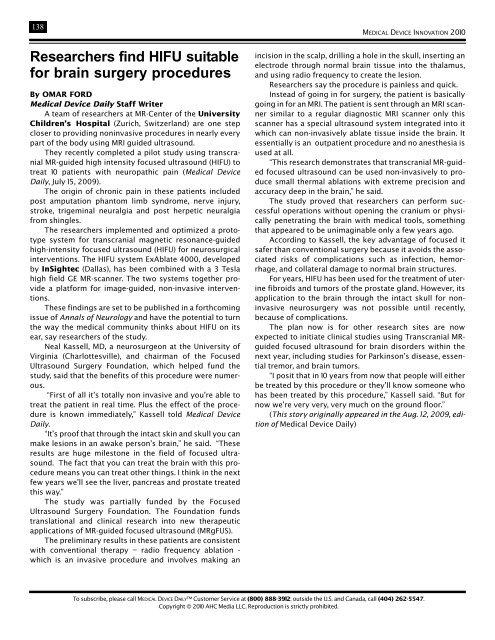MEDICAL DEVICE INNOVATION - Medical Device Daily
MEDICAL DEVICE INNOVATION - Medical Device Daily
MEDICAL DEVICE INNOVATION - Medical Device Daily
Create successful ePaper yourself
Turn your PDF publications into a flip-book with our unique Google optimized e-Paper software.
138<br />
Researchers find HIFU suitable<br />
for brain surgery procedures<br />
By OMAR FORD<br />
<strong>Medical</strong> <strong>Device</strong> <strong>Daily</strong> Staff Writer<br />
A team of researchers at MR-Center of the University<br />
Children’s Hospital (Zurich, Switzerland) are one step<br />
closer to providing noninvasive procedures in nearly every<br />
part of the body using MRI guided ultrasound.<br />
They recently completed a pilot study using transcranial<br />
MR-guided high intensity focused ultrasound (HIFU) to<br />
treat 10 patients with neuropathic pain (<strong>Medical</strong> <strong>Device</strong><br />
<strong>Daily</strong>, July 15, 2009).<br />
The origin of chronic pain in these patients included<br />
post amputation phantom limb syndrome, nerve injury,<br />
stroke, trigeminal neuralgia and post herpetic neuralgia<br />
from shingles.<br />
The researchers implemented and optimized a prototype<br />
system for transcranial magnetic resonance-guided<br />
high-intensity focused ultrasound (HIFU) for neurosurgical<br />
interventions. The HIFU system ExAblate 4000, developed<br />
by InSightec (Dallas), has been combined with a 3 Tesla<br />
high field GE MR-scanner. The two systems together provide<br />
a platform for image-guided, non-invasive interventions.<br />
These findings are set to be published in a forthcoming<br />
issue of Annals of Neurology and have the potential to turn<br />
the way the medical community thinks about HIFU on its<br />
ear, say researchers of the study.<br />
Neal Kassell, MD, a neurosurgeon at the University of<br />
Virginia (Charlottesville), and chairman of the Focused<br />
Ultrasound Surgery Foundation, which helped fund the<br />
study, said that the benefits of this procedure were numerous.<br />
“First of all it’s totally non invasive and you’re able to<br />
treat the patient in real time. Plus the effect of the procedure<br />
is known immediately,” Kassell told <strong>Medical</strong> <strong>Device</strong><br />
<strong>Daily</strong>.<br />
“It’s proof that through the intact skin and skull you can<br />
make lesions in an awake person’s brain,” he said. “These<br />
results are huge milestone in the field of focused ultrasound.<br />
The fact that you can treat the brain with this procedure<br />
means you can treat other things. I think in the next<br />
few years we’ll see the liver, pancreas and prostate treated<br />
this way.”<br />
The study was partially funded by the Focused<br />
Ultrasound Surgery Foundation. The Foundation funds<br />
translational and clinical research into new therapeutic<br />
applications of MR-guided focused ultrasound (MRgFUS).<br />
The preliminary results in these patients are consistent<br />
with conventional therapy – radio frequency ablation -<br />
which is an invasive procedure and involves making an<br />
<strong>MEDICAL</strong> <strong>DEVICE</strong> <strong>INNOVATION</strong> 2010<br />
incision in the scalp, drilling a hole in the skull, inserting an<br />
electrode through normal brain tissue into the thalamus,<br />
and using radio frequency to create the lesion.<br />
Researchers say the procedure is painless and quick.<br />
Instead of going in for surgery, the patient is basically<br />
going in for an MRI. The patient is sent through an MRI scanner<br />
similar to a regular diagnostic MRI scanner only this<br />
scanner has a special ultrasound system integrated into it<br />
which can non-invasively ablate tissue inside the brain. It<br />
essentially is an outpatient procedure and no anesthesia is<br />
used at all.<br />
“This research demonstrates that transcranial MR-guided<br />
focused ultrasound can be used non-invasively to produce<br />
small thermal ablations with extreme precision and<br />
accuracy deep in the brain,” he said.<br />
The study proved that researchers can perform successful<br />
operations without opening the cranium or physically<br />
penetrating the brain with medical tools, something<br />
that appeared to be unimaginable only a few years ago.<br />
According to Kassell, the key advantage of focused it<br />
safer than conventional surgery because it avoids the associated<br />
risks of complications such as infection, hemorrhage,<br />
and collateral damage to normal brain structures.<br />
For years, HIFU has been used for the treatment of uterine<br />
fibroids and tumors of the prostate gland. However, its<br />
application to the brain through the intact skull for noninvasive<br />
neurosurgery was not possible until recently,<br />
because of complications.<br />
The plan now is for other research sites are now<br />
expected to initiate clinical studies using Transcranial MRguided<br />
focused ultrasound for brain disorders within the<br />
next year, including studies for Parkinson’s disease, essential<br />
tremor, and brain tumors.<br />
“I posit that in 10 years from now that people will either<br />
be treated by this procedure or they’ll know someone who<br />
has been treated by this procedure,” Kassell said. “But for<br />
now we’re very very, very much on the ground floor.”<br />
(This story originally appeared in the Aug. 12, 2009, edition<br />
of <strong>Medical</strong> <strong>Device</strong> <strong>Daily</strong>)<br />
To subscribe, please call <strong>MEDICAL</strong> <strong>DEVICE</strong> DAILY Customer Service at (800) 888-3912; outside the U.S. and Canada, call (404) 262-5547.<br />
Copyright © 2010 AHC Media LLC. Reproduction is strictly prohibited.
















